高中英语优秀教案(英文模板)Teaching plan
高中英语教学设计案例5篇
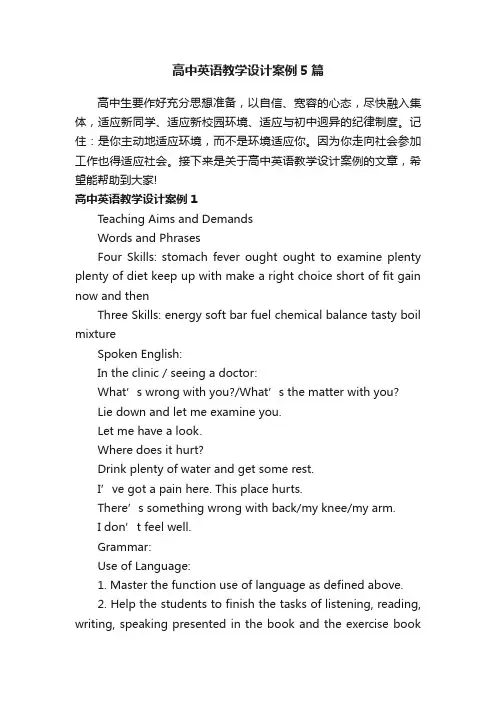
高中英语教学设计案例5篇高中生要作好充分思想准备,以自信、宽容的心态,尽快融入集体,适应新同学、适应新校园环境、适应与初中迥异的纪律制度。
记住:是你主动地适应环境,而不是环境适应你。
因为你走向社会参加工作也得适应社会。
接下来是关于高中英语教学设计案例的文章,希望能帮助到大家!高中英语教学设计案例1Teaching Aims and DemandsWords and PhrasesFour Skills: stomach fever ought ought to examine plenty plenty of diet keep up with make a right choice short of fit gain now and thenThree Skills: energy soft bar fuel chemical balance tasty boil mixtureSpoken English:In the clinic / seeing a doctor:What’s wrong with you?/What’s the matter with you?Lie down and let me examine you.Let me have a look.Where does it hurt?Drink plenty of water and get some rest.I’ve got a pain here. This place hurts.There’s something wrong with back/my kn ee/my arm.I don’t feel well.Grammar:Use of Language:1. Master the function use of language as defined above.2. Help the students to finish the tasks of listening, reading, writing, speaking presented in the book and the exercise bookthrough using what the students have learned.Learn the text about healthy eating. Get the students know about the basic knowledge of how to eat healthily.Important points:1. Talk about different kinds of food that one favorites.2. learn the basic knowledge of healthy eating.3. learn how to say in the clinic.4. Grasp the language points and grammar in the text.Difficult points: The use of modal verbs --- had better, should and ought to.Teaching aids: computer or slider-projectorWay of Teaching: Communication way of teaching, discussion and group work.Lesson 1Step 1 Warming-UpFirst show the students some pictures of dishes and so to introduce the topic of this unit.And then show the pictures on their text books and let them to decide what is junk food and what is not.Here the students may have a short ask and answer in pairs to themselves more engaged in the topic.Step 2 ListeningLet the students listen to the tape and be prepared to answer the questions below.Step 3 SpeakingShow the students the three situations as on P2. Then ask the students to prepared a dialogue according to the examples in pairs. Ask several pairs of students to present their dialogue After that list the useful expressions in their dialogue.Step 4 HomeworkPrepare for the next class.Collect some menus if possible for the next class.Lesson 2Step 1 IntroductionUsing the questions on P3 to introduce the new text.Step 2 Fast-reading1.What does the “fuel ” mean in the first paragraph?(It means different kinds of materials, such as protein, Calcium that we need to keep healthy.)2.What do we have to consider when we choose to buy or eat?(What kinds of nutrients that the food contain.)3.What made our eating habit changing?(Many things: what people believe, advice from companies and stores.)4. How can we feel and look fine?(We ought to learn about our body and the fuel it needs to keep fit.)Explain the language points if necessary.Step 3 Carefully-readingHow many parts can be divided into?(Three parts.)What’s the main idea of each part?(1.our eating habits are changing. 2.why the eating habits are changing 3.the best way to develop healthy eating habits.) Step 4 TalkingAsk the students to take out their menus and read them carefully. Then prepare a dialogue that may happen between a customer and a waiter/waitress.Step 5 HomeworkFinish the exercise --- Vocabulary on P5. and P72-73Lesson 3Step 1 RevisionCheck the homework.Step 2 GrammarFirst present the students the modal sentences with Modal Verbs and ask the students to make some sentences with them.Step 3 Consolidation(1) Finish the exercise on P5 and on P74(2)Take out a piece of paper with the column “Ask ###” in order to make the students understand when you are giving advice it is better to use some sentences with had better (not), and ought(not) to, should(not). Then read a passage as an example and afterwards list the points you have to pay attention to when you give advice.1.give advice that will really help the person.2. be polite and sincereat last get the students to finish the following practice.Step 4 HomeworkFinish the exercise 3 on P74 in the students’ workbook.Lesson 4Step 1 RevisionLet some students read their reply to the letters on P74.Step 2 ReadingRead the text on P6 and then get the students to find the main idea of it (Snacks is also important . we need to learn something about snacks and the way to prepare it.)Step 3 WritingAsk the students to work in pairs to write the recipe for their favourite dish.We may first give the tips on P7 as a guide.Step 4 DiscussionFirst ask the students to read the passage on P75 and then give the following questions as the topic for the students to talk: What is a couch potato?What does one have to pay special attention to in order to keep healthy? (food and exercise etc.)Step 5 HomeworkDo a general survey in order to learn about the differences between people’s eating habits and try to find which is healthier.高中英语教学设计案例2Teaching aims and demands:a. Achieve language skills and related knowledge about the topic of friends and friendship;b. Learn to express likes and dislikes and make apologies:c. Vocabulary in this unit:the words and expressions listed on the teacher’s bookd. Grammar:Direct and indirect speechLesson 1Step 1 Presentation and discussion (warm-up)Put some new words on the blackboard and tell them something about a friend.Kind honest brave loyal happy wise strongbeautiful handsome rich smart funnyThen ask some questions around the class and discuss with them.What should a good friend be like?What qualities should a good friend have?Should they be funny, smart and strong?Step 2 ReadingAsk the students to read the dialogue in the part SPEAKING. Ask some questions:1.What doesn’t John like?2.What does Joe think of music and skiing?And then fill in the form on page 3.Then ask the students to express their ideas freely. Encourage the students to say more about friends.Step 3ListeningAsk the students to listen to the tape and fill in the blanks in the listening part.Step 4 Talking/PracticeAsk the students to page 85. Make a similar dialogue as in exercise 2.Some useful expressions :Why did you…? Why didn’t you…? You said that you would…Please forgive me. You promised to … I’m very sorry… It won’t happen again. I forgot.Step 5 HomeworkFinish Exercise 3 in the workbook.Lesson2Step1 RevisionAsk several students to present a speech about friends as a revision.Step 2 Pre-readingPresent the students a picture to illustrate the situation on a lonely island. Ask them to list three items in the box and ask them to give the reasons using the sentences listed on page3.Step 3 ReadingBefore asking the students to read the text, first give the students a brief introduction about Tom Hanks, his films and the film Cast Away.Then students read the text, and answer the following questions.1.How does Chuck Noland come to a deserted island?2. In order to survive on the island alone, what does he need to learn?3. What does he understand at last?4. For us, what lesson we can learn from Chuck?At the same time explain the language points if necessary.Step 4 Post-readingDiscuss the following questions in the Part POST-READING.Step 5 HomeworkPrepare a talk about Tom Hanks or something about one of his film.Lesson3Step 1 RevisionGet the students to give a talk about Tom Hanks or something about one of his films.Step 2 Language StudyAsk the students fill in the blanks with proper words.Step 3 GrammarIllustrate to the students the use of Direct and Indirect Speech.Then ask the students to do the exercise in the Part Grammar on P5.Step 4 PracticeAsk the students to act the exercise2 in the part Grammar out.Step 5 HomeworkAsk the students to finish the exercise2 in their workbook.Lesson4Step 1 RevisionCheck the homework.Step 2 PresentationPresent simples of e-mail to get the students a general idea of e-mail.Step 3 ExplanationTell the students some tips of writing an e-mail by learn the above e-mail simple.Step 4 WritingAsk the students to write an e-mail message.Step 5 HomeworkAsk the students to try to write an e-mail to their e-pal.高中英语教学设计案例3Ⅰ. Teaching Basis (教学依据) :《普通高中英语新课程标准》Ⅱ. The Type of the Text (课型) :Revision (复习课)Ⅲ. Teaching Methods(教学方法): Question-based method(提问式),Group discussionmethod(小组讨论法),Cooperative learning(合作探究),Practicing(练习).Ⅳ. Teaching Aids (教学手段) :Multimedia computer(多媒体电脑),Learningpaper(导学案),Blackboard(黑板).Ⅴ. Teaching Aims(教学目标) :①Knowledge aims(知识目标): words: achievement, specialist, organization, hard-working, confident….. phrases: put to death, mean doing, either…or…, the bond between……, structure: only+…., It is/was+….+that…. grammar: Subject-verb agreement.②Ability aims(能力目标): Develop the students’ ability to use the importantlanguage points, enable students to describe people using the adjectives.③Emotional aims(情感目标): Encourage the students to think about what makes aperson great.Ⅵ. Teaching focuses(教学重点):Get the students to review and consolidate what theyhave learned in this unit.Ⅶ. Teaching difficulties(教学难点):Get the students to turn what they have learned intotheir ability.Ⅷ.Teaching procedure(教学过程): Step 1 复习学案情况反馈(1分钟)Step 2 lead-in :通过图片展示的方式,过渡到知识竞答类节目《一站到底》,本节课也将模仿这种模式授课。
高中英语优秀教案英文版
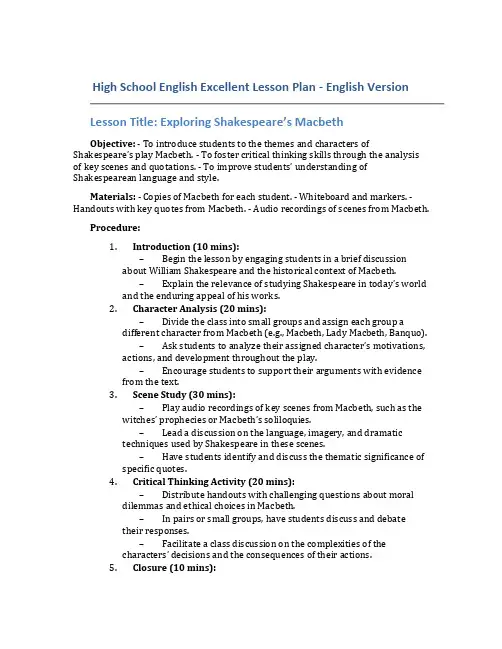
High School English Excellent Lesson Plan - English VersionLesson Title: Exploring Shakespeare’s MacbethObjective: - To introduce students to the themes and characters of Shakespeare’s play Macbeth. - To foster critical thinking skills through the analysis of key scenes and quotations. - To improve students’ understanding of Shakespearean language and style.Materials: - Copies of Macbeth for each student. - Whiteboard and markers. - Handouts with key quotes from Macbeth. - Audio recordings of scenes from Macbeth.Procedure:1.Introduction (10 mins):–Begin the lesson by engaging students in a brief discussion about William Shakespeare and the historical context of Macbeth.–Explain the relevance of studyi ng Shakespeare in today’s world and the enduring appeal of his works.2.Character Analysis (20 mins):–Divide the class into small groups and assign each group a different character from Macbeth (e.g., Macbeth, Lady Macbeth, Banquo).–Ask students to analyze t heir assigned character’s motivations, actions, and development throughout the play.–Encourage students to support their arguments with evidence from the text.3.Scene Study (30 mins):–Play audio recordings of key scenes from Macbeth, such as the witches’ prophecies or Macbeth’s soliloquies.–Lead a discussion on the language, imagery, and dramatic techniques used by Shakespeare in these scenes.–Have students identify and discuss the thematic significance of specific quotes.4.Critical Thinking Activity (20 mins):–Distribute handouts with challenging questions about moral dilemmas and ethical choices in Macbeth.–In pairs or small groups, have students discuss and debate their responses.–Facilitate a class discussion on the complexities of thecharacters’ decision s and the consequences of their actions.5.Closure (10 mins):–Summarize the key points covered in the lesson and review the themes and characters of Macbeth.–Invite students to share their personal reflections on the play and its relevance to modern society.–Assign a short writing task for homework, asking students to analyze a specific scene or character in Macbeth.By following this structured lesson plan, students will develop a deeper appreciation for Shakespeare’s plays and enhance their analytical and interpretive skills. Through close reading and thoughtful discussion, students will uncover the timeless themes and universal truths of Macbeth, making connections between the text and their own lives.。
高中英语阅读理解教案范文全英文
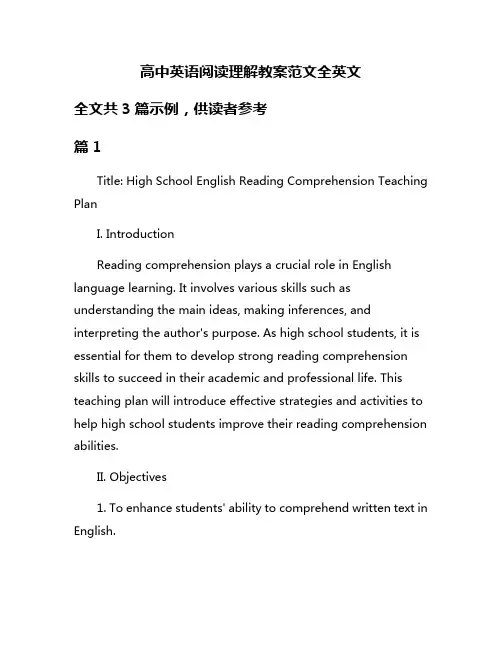
高中英语阅读理解教案范文全英文全文共3篇示例,供读者参考篇1Title: High School English Reading Comprehension Teaching PlanI. IntroductionReading comprehension plays a crucial role in English language learning. It involves various skills such as understanding the main ideas, making inferences, and interpreting the author's purpose. As high school students, it is essential for them to develop strong reading comprehension skills to succeed in their academic and professional life. This teaching plan will introduce effective strategies and activities to help high school students improve their reading comprehension abilities.II. Objectives1. To enhance students' ability to comprehend written text in English.2. To improve students' critical thinking skills through reading.3. To help students analyze and interpret different types of texts.4. To expand students' vocabulary and language proficiency.5. To develop students' confidence in reading and interpreting complex texts.III. Strategies1. Pre-reading Activities: Before reading a text, students can engage in activities such as predicting the content based on the title or images, discussing their prior knowledge on the topic, or brainstorming questions they have about the text.2. During-reading Activities: While reading, students can highlight key information, identify the main ideas and supporting details, and monitor their understanding by summarizing the text after each paragraph or section.3. Post-reading Activities: After reading, students can engage in discussions about the text, share their opinions and interpretations, answer comprehension questions, or write a summary or reflection on what they have read.4. Vocabulary Building: Introducing new vocabulary words and idioms from the text, and providing opportunities for students to use these words in context through exercises or discussions.5. Critical Thinking Exercises: Encouraging students to analyze the author's purpose, make inferences, identify biases, and evaluate the credibility of the information presented in the text.IV. Sample Lesson PlanTitle: Understanding Non-Fiction TextsObjective: To help students develop skills in comprehending and analyzing non-fiction texts.1. Warm-up (10 minutes)- Discuss the difference between fiction and non-fiction texts.- Brainstorm examples of non-fiction texts such as newspaper articles, essays, and scientific reports.2. Pre-reading Activity (10 minutes)- Show students the title and subtitles of a non-fiction article.- Ask students to make predictions about the content based on the title and subtitles.3. Reading (30 minutes)- Ask students to read the non-fiction article individually.- Encourage students to highlight key information, identify the main ideas and supporting details.- Monitor students' progress and provide support as needed.4. Post-reading Activities (20 minutes)- Divide students into small groups to discuss the main ideas of the text and share their interpretations.- Ask students to answer comprehension questions about the text.- Have students write a summary or reflection on what they have learned from the article.5. Vocabulary Building (10 minutes)- Introduce new vocabulary words from the text and discuss their meanings and usage.- Provide exercises for students to practice using the new words in sentences.6. Critical Thinking Exercise (10 minutes)- Ask students to analyze the author's purpose and identify biases in the text.- Discuss the credibility of the information presented and encourage students to form their own opinions.V. ConclusionBy implementing effective strategies and activities in teaching reading comprehension, high school students can improve their language skills, critical thinking abilities, and confidence in reading and interpreting complex texts. This teaching plan provides a framework for educators to help students develop the necessary skills to succeed in their academic and professional endeavors.篇2High School English Reading Comprehension Teaching PlanI. IntroductionReading comprehension is a vital skill for high school students to develop, as it not only enhances their academicperformance but also improves their overall language proficiency. This teaching plan aims to effectively teach high school students how to improve reading comprehension skills.II. Objectives1. To enhance students' ability to understand and interpret various types of texts.2. To improve students' vocabulary and language usage.3. To develop critical thinking skills through reading and analyzing texts.4. To help students draw connections between texts and real-life situations.III. Strategies1. Pre-reading activities: Before reading a text, engage students in activities such as brainstorming, predicting, and activating prior knowledge. This helps set the context for the text and prepares students for what they are about to read.2. During-reading activities: While students are reading a text, encourage them to use active reading strategies such as highlighting key information, making annotations, and askingquestions. This helps students stay focused and ensures better comprehension.3. Post-reading activities: After reading a text, have students engage in activities such as summarizing, analyzing, discussing, and interpreting the text. This helps reinforce comprehension and allows students to reflect on the text.IV. Lesson Plan1. Introduction to reading comprehension: Start the lesson by explaining the importance of reading comprehension and its relevance to academic success. Provide examples of how reading comprehension skills can be applied in various contexts.2. Pre-reading activity: Choose a text that is appropriate for the students' proficiency level and interests. Engage students in a pre-reading activity such as predicting the content of the text based on the title or images.3. During-reading activity: Ask students to read the text individually or in pairs and actively engage with the text by highlighting key information, making annotations, and asking questions.4. Post-reading activity: Have students discuss the text in groups, summarize the main ideas, analyze the text's structure,and draw connections to real-life situations. Encourage students to express their opinions and interpretations of the text.V. AssessmentAssess students' reading comprehension skills through various methods such as quizzes, writing assignments, class discussions, and presentations. Provide constructive feedback to help students improve their comprehension skills.VI. ConclusionReading comprehension is a crucial skill that high school students need to develop to succeed academically and in life. By implementing effective teaching strategies and engaging students in various activities, educators can help students improve their reading comprehension skills and become better readers and critical thinkers.篇3High School English Reading Comprehension Lesson PlanObjective:- To improve students' comprehension skills through reading and answering questions based on a variety of texts.- To develop students' critical thinking skills by analyzing and interpreting information from different sources.- To enhance students' vocabulary and grammar skills by exposing them to a range of reading materials.Materials:- A selection of reading passages on various topics (e.g. news articles, short stories, poems)- Reading comprehension questions for each passage- Highlighters or colored pens for marking important information- Answer keys for the comprehension questions- Whiteboard and markers for class discussionProcedure:1. Warm-up (10 minutes):- Begin the lesson by asking students to discuss in pairs or small groups about what reading comprehension means to them.- Engage the students in a short discussion about the importance of being able to understand and interpret written texts.2. Introduction to the Lesson (5 minutes):- Explain to the students that today's lesson will focus on improving their reading comprehension skills through various activities.- Provide an overview of the objectives and outcomes of the lesson to set the students' expectations.3. Reading and Comprehension Activities (40 minutes):- Divide the students into small groups and distribute the reading passages and comprehension questions.- Instruct the students to read the passage carefully, highlighting or underlining important information as they go.- Encourage students to work together in their groups to answer the comprehension questions, referring back to the text for evidence and support.- Walk around the classroom, monitoring the students' progress and providing assistance where needed.- Once the groups have completed the questions, reconvene as a class to discuss the answers and address any areas of confusion or misunderstanding.- Review the correct answers with the class and reinforce key vocabulary and grammar concepts that were covered in the passages.4. Extension Activities (15 minutes):- To further enhance the students' comprehension skills, provide additional reading passages or texts for them to work on individually or in pairs.- Encourage students to write short summaries or reflections on the texts they have read, focusing on the main ideas and key points.- Challenge the students to identify and analyze different perspectives or interpretations within the text, promoting critical thinking and analysis skills.5. Closure (5 minutes):- Conclude the lesson by reviewing the key concepts and skills that were covered during the class.- Encourage students to continue practicing their reading comprehension skills by reading regularly and engaging with a variety of texts.- Provide positive feedback and reinforcement to motivate the students and reinforce their learning.Assessment:- Assess students' comprehension skills through their responses to the reading comprehension questions and their participation in class discussions.- Monitor students' progress over time by evaluating their ability to analyze and interpret texts effectively.- Provide feedback and guidance to help students improve their reading comprehension skills and achieve their learning goals.Overall, this lesson plan is designed to help high school students develop and enhance their reading comprehension skills through engaging and interactive activities. By providing a variety of reading materials and opportunities for discussion and analysis, students will be able to improve their comprehension abilities and become more proficient readers.。
高中英语的教案英文
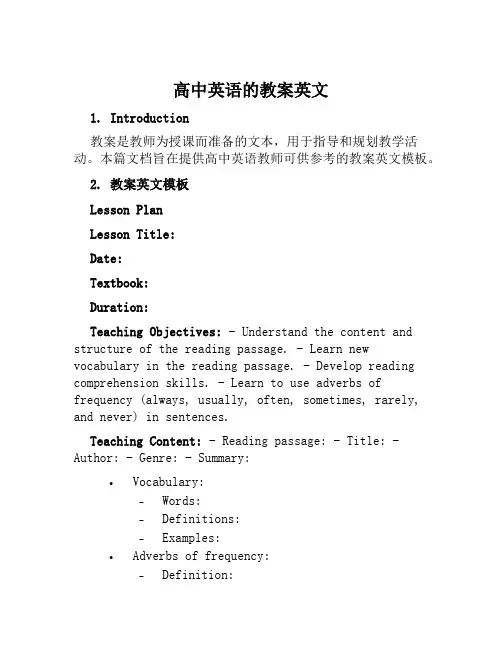
高中英语的教案英文1. Introduction教案是教师为授课而准备的文本,用于指导和规划教学活动。
本篇文档旨在提供高中英语教师可供参考的教案英文模板。
2. 教案英文模板Lesson PlanLesson Title:Date:Textbook:Duration:Teaching Objectives: - Understand the content and structure of the reading passage. - Learn new vocabulary in the reading passage. - Develop reading comprehension skills. - Learn to use adverbs of frequency (always, usually, often, sometimes, rarely, and never) in sentences.Teaching Content: - Reading passage: - Title: - Author: - Genre: - Summary:•Vocabulary:–Words:–Definitions:–Examples:•Adverbs of frequency:–Definition:–Examples:Teaching Procedures: 1. Warm-up: - Introduction of topic. - Pre-reading activity.2.Reading:–Reading the passage aloud.–Reading comprehension questions.3.Vocabulary:–Vocabulary practice activities.–Vocabulary assessment.4.Grammar:–Explanation and practice of adverbs of frequency.5.Writing:–Writing activity using new vocabulary.6.Assessment:–Summative assessment.7.Closure:–Wrap-up activity.Unit PlanUnit Title:Textbook:Duration:Teaching Objectives: - Develop listening, speaking, reading, and writing skills. - Learn new vocabulary in the unit. - Develop understanding of grammar rules. - Gn knowledge of cultural aspects of the targetlanguage. - Be able to communicate in the target language using appropriate grammar and vocabulary.Teaching Content: - Topics: - Topic 1: - Topic 2: - Topic 3:•Vocabulary:–Words:–Definitions:–Examples:•Grammar:–Grammar rules:–Examples:–Practice activities:•Cultural aspects:–Information about cultural aspects.Teaching Procedures: 1. Pre-assessment: - Assessment of prior knowledge.2.Introduction:–Introduction of unit topic.–Explanation of objectives andexpectations.3.Vocabulary:–Introduction of new vocabulary.–Practice activities.4.Reading and listening:–Reading and listening activities.5.Speaking and writing:•Speaking practice and assessment.•Writing practice and assessment.6.Grammar:–Grammar explanation and practiceactivities.7.Cultural aspects:•Exploration of cultural aspects.8.Summative assessment:–Assessment of learning outcomes.9.Conclusion:–Reflection on learning objectives and outcomes.–Feedback and suggestions for future improvement.3. Conclusion以上是高中英语的教案英文模板,可根据具体教学内容进行实际操作。
(推荐)高中英语优秀教案(英文模板)Teachingplan
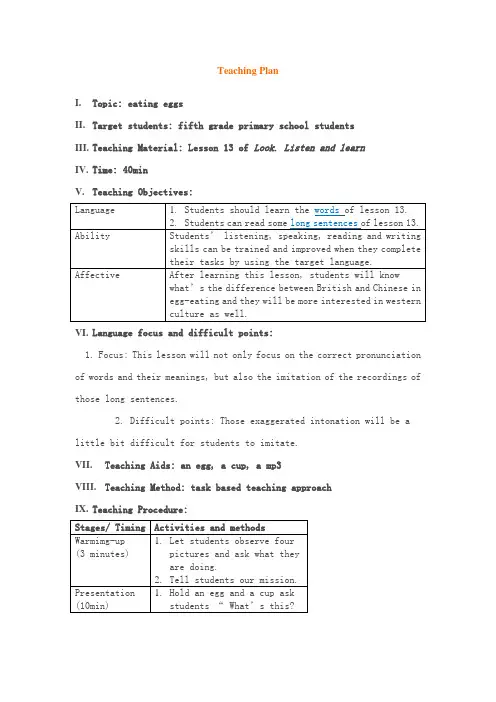
I.Topic: eating eggs
II.Target students:fifth grade primary schoolstudents
III.Teaching Material: Lesson 13 ofLook. Listen and learn
IV.Time: 40min
2.Let students demonstrate how British eat soft boiled eggsaccordingto these sentences.
Homework
(1 minute)
1.Copy the words in the textbook..
2.Follow the recordings of lesson 13.
Presentation
(10min)
1.Hold an egg and a cup ask students“What’s this?
”
2.Teach word egg-cup.
3.Teach sentence through mp3.
Play a game(5min)
Give prize to students who imitate the mp3.
V.TeachingObjectives:
Language
1.Studentsshould learn thewordsof lesson13.
2.Students can read somelong sentencesof lesson 13.
Ability
Students’ listening, speaking, reading and writing skills can be trained and improved when they complete their tasks by using the target language.
高中英语教案英文版5篇

高中英语教案英文版5篇高中英语教案英文版5篇教案可以恰当地选择和运用教学方法,调动学生学习的积极性,面向大多数学生,同时注意培养优秀生和提高后进生,使全体学生都得到发展。
以下是带来的内容,感谢您的阅读,希望能帮助到您!高中英语教案英文版1Teaching Procedures of Period 1:Step1.Warming up (15 mins)Ss know a lot about sports from everyday life and media, so I arrange sucha task -discussion(group of 4): Q: What do you know about sports?During this process, if Ss can’t express themselves in English, Chinese isalso all right. Besides, it is agood chance to present new words. If necessary, I will make somecomplements. At the same time, I will present them as many pictures about sportsas possible.Possible response:school sports meetSports meet the National Gamesthe Asian Gamesthe Olympic Gamesthe World Cupetcball games: volleyball, basket ball, football, table tennis, tennis,,golfbadminton, bowling, baseball, American football, ice hockey etcEvents of sports track and field: relay race, long jump, high jump, polejump, discus, shot, javelin etcgymnastic: rings, double bars, high and low bars, horse , free exerciseswimming/shooting/skiing/ ice sports/diving/aquatic sports etcSport stars : Beckham, Mike Owen, Michael Jordan etc Purpose: This activity is designed to encourage students to think aboutsports and activaterelevant vocabulary.Step 2. Speaking(15 mins)Task1(pair work): Talk about their favourite sports, favourite sportsstars, and the reason why they like them, with the following expressions as aguide.(See SB p52) Task2(pair work): A survey about physical fitness (Seepostscript 1)Task3(group work): Add up their total scores and divide by the number ofpeople. Then get their group’s average scores. Discuss their survey answers.1). Do you think your group is doing well or not? Why ?2). How can you become fitter?高中英语教案英文版2教学目标Teaching aims and demands本单元的教学目标是使学生掌握表示判断和个人看法的常用语句,学会使用现在完成时的被动语态。
高一英语The teaching plan 优秀教案
The teaching planforBook 1 Module 1 Period 4 GrammarBy Chengdu Northwest High School Zheng XueThe General Idea of This PeriodIn this period, we’ll review the use of the present tense by practicing.Teaching AimReview the present tense.Teaching Important PointFinish some exercises to review the present tense.Teaching Difficult PointHow to improve the students’ ability.Teaching Aids1. the blackboard2. the multimediaTeaching ProceduresStep 1 Greetings and RevisionStep 2 Grammar 11、the present simple tense:①.表示经常性;习惯性的动作或存在的状态。
常与usually, often, always, every day, sometimes, once amonth, never, on Mondays 等时间状语连用。
e.g. He never gives up, whenever he fails.②表示普遍真理和客观存在的事实。
e.g. A plane travels more quickly than any other traffic.③表示现在时刻发生的动作或存在的状态。
e.g. It’s Sunday today. He is at church.④表示与安排、方案或时刻表有关的动作。
常用于转移动词。
全英教案模板Teaching plan3
5.辨音:s, x
Whenhear the word with the sound/s/, Ss should raise their left hands. When hear the word with the sound/ks/,Ss
Feedback onLesson Plan
扩展单词时,可适当增加难度,加入一些较难拼读或拼写的单词。
STAGE OF
LESSON
TEACHER PARTICIPATION
STUDENT PARTICIPATION
Time
Organization
Teacher Activities/language
边说故事边呈现新单词mug, rug, run, sun, cut, nut(纵列书写)
1.齐拼单词(字母操),带读,叫号检查;
2.TPR操练单词
3.在单词旁标上数字,老师读数字,学生读词。
4.找规律,让学生说出字母u在此情况下的发音,并迅速说出含相同发音的单词(如bun, fun, hug等)。
5.书写音标/ʌ/.让学生在黑板示范。加入辅音字母进行音标拼读。
Guess what it is.
Pass the pictures by their shoulders and say the words.
Say the word with/ks/sound.
Sing the song.(TPR)
Whenhear the word with the sound/s/, Ss should raise their left hands. When hear the word with the sound/ks/, Ss should raise their right hands.
高中英语教案(英文模板)Teachingplan
高中英语优秀教案(英文模板)Teachingplan一、教学目标:1. 知识目标:学生能够掌握并运用本课核心词汇和短语。
学生能够理解并运用本课所学的语法知识。
2. 能力目标:学生能够提高听力理解能力,能听懂并准确回答问题。
学生能够提高口语表达能力,能够流畅地用英语进行对话。
3. 情感目标:学生能够激发对英语学习的兴趣,培养积极的学习态度。
二、教学内容:1. 词汇和短语:学生需要掌握本课中的核心词汇和短语,并能运用到实际情境中。
2. 语法知识:学生需要理解并掌握本课所学的语法知识,能够正确运用到句子中。
三、教学过程:1. 导入:通过与学生的生活相关的场景引入本课主题,激发学生的兴趣和好奇心。
2. 词汇和短语教学:通过例句、游戏等方式教授本课核心词汇和短语,让学生在实际情境中进行运用。
3. 语法知识教学:通过例句、练习等方式教授本课所学的语法知识,让学生能够正确运用到句子中。
四、作业布置:1. 词汇和短语练习:让学生完成相关的词汇和短语练习题,巩固所学知识。
2. 口语作业:让学生与同学进行对话练习,提高口语表达能力。
五、教学评价:1. 课堂参与度:观察学生在课堂上的积极参与程度和表现。
2. 作业完成情况:检查学生完成作业的情况,巩固所学知识。
3. 口语表达能力的提高:通过对话练习,评估学生的口语表达能力是否有提高。
六、教学策略:1. 任务型教学法:通过设计各种真实的任务,让学生在完成任务的过程中运用所学知识,提高语言运用能力。
2. 交际式教学法:鼓励学生积极参与课堂对话,培养学生的交际能力和团队合作精神。
3. 情境教学法:创设各种真实的学习情境,让学生在实际情境中感知和运用语言。
七、教学资源:1. 教材:使用符合课程标准的高中英语教材,为学生提供丰富的学习内容。
2. 多媒体设备:利用多媒体课件、视频等资源,丰富教学手段,提高学生的学习兴趣。
3. 网络资源:利用网络资源,为学生提供更多的学习资料和实践平台。
高中英语优秀教案Teachingplan
VII.Teaching Aids: an egg, a cup, a mp3
VIII.Teachi ng Method: task based teach ing approach
13.
X. Self-reflection
Prese ntati on (10mi n)
1.Teach words.
2.Teach sentences.
3.Let stude nts dem on strate the senten ce.
Play a game (12mi n)
1.Let students read the three senten ces loudly.
Teach ing Plan
I.Topic: eati ng eggs
II.Target stude nts: fifth grade primary school stude nts
III.Teach ing Material: Less on 13 of Look. Liste n and lear n
2.Let stude nts dem on strate how British eat soft boiled eggs accordi ng to these senten ces.
Homework (1 mi nute)
1.Copy the words in the textbook..
2.Follow the recordi ngs of less on
IX. Teaching Procedure:
- 1、下载文档前请自行甄别文档内容的完整性,平台不提供额外的编辑、内容补充、找答案等附加服务。
- 2、"仅部分预览"的文档,不可在线预览部分如存在完整性等问题,可反馈申请退款(可完整预览的文档不适用该条件!)。
- 3、如文档侵犯您的权益,请联系客服反馈,我们会尽快为您处理(人工客服工作时间:9:00-18:30)。
After learning this lesson, students willknowwhat’s the differencebetween British and Chinese in egg-eating and they will be moreinterestedin western culture as well.
Teaching Plan
I.Topic: eating eggs
II.Target students:fifth grade primary schoolstudents
III.Teaching Material: Lesson 13 ofLook. Listen and learn
IV.Time: 40min
X.Self-reflection
XI.如有侵权请联系告知删除,感谢你们的配合!
XII.
XIII.
XIV.
Presentation
(10min)
1.Hold an egg and a cup ask students“What’s this?”
2.Teach word egg-cup.
3.Teach sentence through mp3.
Play a game(5min)
Give prize to students who imitate the mp3.
Presentation
(10min)
Teach words.
2.Teach sentences.
3.Let studentsdemonstratethe sentence.
Play a game
(12min)
1.Let students read the three sentences loudly.
2.Difficult points: Thoseexaggeratedintonation will be a little bit difficult for students to imitate.
VII.Teaching Aids:an egg, a cup, a mp3
VIII.Teaching Method: task based teaching approach
V.TeachingObjectives:
Language
1.Studentsshould learn thewordsof lesson13.
2.Students can read somelong sentencesof lesson 13.
Ability
Students’ listening, speaking, reading and writing skills can be trained and improved when they complete their tasks by using the target language.
nguage focus and difficult points:
1.Focus: This lesson willnot onlyfocus on the correct pronunciation of words and theirmeanings, but also the imitation of the recordings of those long sentences.
2.Let students demonstrate how British eat soft boiled eggsaccordingto these sentences.
Homework
(1 minute)
1.Copy the words in the textbook..
2.Follow the recordings of lesson 13.
IX.Teaching Procedure:
Stages/ Timing
Activities and methods
Warmimg-up
(3minutes)
1.Letstudentsobserve four pictures and ask whatthey aredoing.
2.Tell students our mission.
